





NICK WANGLER ’27 STAFF
WRITER
The Wabash rugby team is by no means a club on campus that students don’t know about. With success on the pitch as a student led organization, the team has gone as far as placing third in the National Collegiate Rugby (NCR) Collegiate Rugby Championship 7’s tournament in Spring 2023 – all without the same support as other sports at Wabash, including a coach. But after coming up short in spring 2024, the team is
excited for a shift that has changed the projection of the season – a coach. Enter Coach Kelly Romano. As the former Carmel High School women’s rugby coach, who led them to three state championships (as well as one state championship with the middle school team), Romano has over 30 years of experience with the sport of rugby.
“The rugby team has always had two long term goals – to get funding to become a varsity sport and to secure a coach,”
said Rugby Captain James Wallace ’26. “With Coach Kelly stepping in as our coach, we are filling one of those voids.”
Coach Romano originally received a call from a few players about putting on a tackling clinic to help the team’s tackling, so she agreed to come up to Wabash to help. After finishing with the clinic, she realized the talent and potential the team had.
“Upon my arrival at the pitch, I was instantly impressed with the players’ willingness to learn
Looks to fund certifcation process for GHI fellows
BEN DOUGLAS ’27
STAFF WRITER
Since the Global Health Institute (GHI) first established its work-study program with the Dr. Mary Ludwig Montgomery County Free Clinic (MCFC), Wabash College has sent numerous students to assist at the clinic over the years in various capacities.
Recently, the MCFC received a grant to fund a certification process for GHI fellows. This grant benefits both the students and the clinic by helping students develop practical skills not typically taught in classrooms, while the clinic receives assistance from students interested in the medical field.
“We received a grant through Wabash that allows our GHI interns to work with us, and they are paid through a work-study program,” said Ashley Menard, the clinic’s executive director. “We’ve already utilized
the funds and signed on three interns: David Leal ’26, Santiago Garcia ’25 and Braeden Cooper ’26.”
“Building relationships with the local community and our GHI students is crucial.”
- Global Health Institute Fellow David Leal ’26
These three Wabash students will be pivotal in supporting the clinic throughout the school year. These students will be translators, as around 90 percent of the individuals that the MCFC serves are Spanishspeaking. The students get the opportunity to work with the clinic because of their participation in the GHI –particularly the work-study program.
“They applied through the college to be part of the GHI program, which is tied to the work-study program,” said Menard. “We have several different sites, including the health department and our clinic.”
For these students, balancing both academics and their part time internship will be a challenge. However, Menard was quick to emphasize the importance of schoolwork.
“It depends on their schedules,” said Menard. “We’re flexible because we understand that academics come first, and we at the clinic try to honor that as much as possible. Their studies are the most important thing to us. They’re here a couple of days a week, depending on their schedules. For example, Santiago is here every Monday and Wednesday for a few hours in the afternoon.”
Continued page 2

PRESTON REYNOLDS ’25
OPINION EDITOR
In the excitement of election season, the vice-presidential debate is usually the bridesmaid, not the bride. However, with just about one month before Election Day on November 5 and no additional debates in sight, a heightened level of attention was dedicated to the verbal spar between Ohio Senator JD Vance (R) and Minnesota Governor Tim Walz (D).
Although the irrelevance of a spat between each presidential candidate’s lieutenant endures, many news commentators and voters have expressed surprise at their cordiality. Both Vance and Walz disagreed in a, largely, respectful manner. The debate began with a handshake and ended with a friendly conversation as they left the stage. The direct agreement between Senator Vance and Governor Walz has
surprised many commentators. Particularly when questioned about gun control, each candidate found themselves disagreeing with tact and agreeing with lukewarm enthusiasm. Viewers interviewed following the debate expressed astonishment at the respectful nature of the exchange, particularly in view of the most recent presidential debates. This is not to say that this debate completely contrasted with that of Vice President Kamala Harris and former President Trump. Multiple times throughout the night, both speakers interrupted the other in brief, but significant moments. And, in a fashion the American people must be used to at this point, moderators Norah O’Donnell and Margaret Brennan had to mute mics.
Continued page 3
and athleticism,” said Coach Romano. “All the players were world-class gentlemen and incredibly gracious. That experience was so exciting. I could not wait to come back and work with the team again.”
After the first training session, Romano agreed to come back for another session.
“The second training session was even better,” said Romano, “The players were truly locked in and their enthusiasm for the sport was contagious.”
After coaching the team for
two sessions, Romano made the decision to take on the coaching role of the squad. This means a lot for what a typical practice session looks like for the team. Previously, all practices and conditioning were run by the captain of the team. The new opportunity of a head coach brings in new ideas and structure. The players are excited to finally have a coach to push them and instill discipline into their game.
Continued page 11
After numerous delays, facility is one step closer to opening
’27
TY MURPHY
STAFF WRITER
With construction taking place on the sidewalks and the Mall parking lot being shut down permanently, it marks the beginning of the end for the historic Sparks Center - a building that has been serving students since 1954. In its place, for the time being, comes the newest Wabash College dining experience, Grub Hollow, and there is a lot to expect.
“Grub Hollow was constructed for us to be able to have a smooth transition right out of Sparks and into that building,” said Bon Appetit General Manager Mary Jo Arthur. “It has a full kitchen, brand new equipment and everything in that space is basically unwrapped and unpackaged.”
Bon Appetit is excited to transition into the temporary dining unit and have been diligently preparing. Both them and the College have a lot they cannot wait to unveil to students about the new way they will be getting their meals.
“There’s hot food, pizza, deli and sandwiches, and there’s more equipment that we’ll bring over from Sparks,” said Adriann Rhoades, the Director of Planning, Design and Construction. “All of the Pepsi machines will be installed here and other drink stations. There’s an L-shaped counter that ends

up coming out in [the dining hall] for condiments and things like that. Salad bars and desserts are out here in the center to allow for circulation. The pizza oven will be coming over, and it’ll go on the back wall, in front of the warmer.”
“[Grub Hollow is] the stepping stone to the next chapter with this new building.”
- Bon Appetit General Manager Mary Jo Arthur
“Our team is super excited to give the students something fresh and new,” said Arthur. “It’s the stepping stone to the next chapter with this new building.”
It’s not just the food stations that will transition to Grub Hollow but also, furniture from Sparks, wall graphics, four 70-inch TVs, air conditioning and more. With all of these exciting additions, Grub Hollow has been nothing short of a busy project. The facility itself is located on the Collett Tennis Courts and is composed of 10 trailer modules that have been driven in and assembled together.
Continued page 3
Many of the features of Sparks will be moved over to Grub Hollow as well as additional equipment. With all of these food stations comes a much larger kitchen with new equipment, more freezers and updated bathrooms for students. Even though much of Sparks is coming over, the College promises a new feel to the area.

OWEN VERMEULEN ’28
STAFF WRITER
South Africa
A mass shooting occurred in the remote town of Lusikisiki, South Africa on Friday, September 27. The shooter targeted two houses on the same street sequentially.
In the first house, the shooter killed 13 individuals – 12 of which were women. Shortly after the attack on the first house, the shooter attacked the neighboring house, leading to four more deaths – three of which were also women. Later, an 18th victim died in the hospital on Sunday, September 29, after succumbing to their wounds.
According to the BBC, the victims were neighbors and relatives in Nyathi Village, Ngobozana in Lusikisiki. They were gathered at the houses in preparation for a traditional mourning ceremony for a mother and daughter who were murdered a year ago.
Several residents were able to hide and said they heard the doors get kicked in as well as the gunshots. While there were no survivors in the first home, there were six survivors at the second home, including a twomonth-old child.
According to the Police Minister Senzo Mchunu the motive for the shootings is still unknown as the police are still in the process of trying to catch the assailant. It is suspected that the perpetrator knew the victims.
This shooting is the latest in a long string of violent murders in South Africa. South Africa currently ranks 6th in the world for homicides per capita.

Austria
On Sunday, September 29, Austria’s far-right Freedom Party won its first national parliamentary election since the end of World War II. After running on a platform centered around citizens’ fears about inflation, the Ukrainian conflict and immigration, amongst other prevalent issues, the Freedom Party ended up winning with 29.2% of the vote and the runner up Austrian People’s Party ended up with 26.5% of the vote.
The incumbent government was a coalition between the Austrian center right People’s Party and the environmentalist Green Party.
In Europe, it is common for countries to have numerous small political parties, rather than the two-party system in the United States. This forces
these smaller parties to form coalitions to assume power – a political alliance between two or more parties that share common interests.
In particular, they are extremely common in governments like Germany, Belgium and Austria. The Freedom Party has long been a force in Austrian politics, but the result of Sunday’s election is its best yet, beating its 1999 result when it carried 26.9% of the vote.
This result has left the second-largest party, the Austrian People’s Party, searching for allies to form a coalition with to make a run at the next election.
As a result of this election, it is likely that the Austrian government will pass more immigration and economic policies looking to restrict immigration numbers and fight inflation.
A regression in Austria’s international presence is also to be expected, as the Freedom Party has said they want to pull out of Germany’s Sky Shield project, a missile defense system, and Ukraine’s war with Russia.
Taiwan

On Sunday, September 29, President Biden approved $567 million to support Taiwan in its defense against China. The US has been Taiwan’s strongest supporter in the international community as Taiwan stands fervently against China to earn their independence.
This is just the US’s latest attempt to reinforce the Taiwanese defense despite China’s demands that it stop. China continues to claim that Taiwan is their territory even though Taiwan has expressly stated otherwise, leading to increasing tension between the two governments.
This renewed support is coming off the heels of Biden signing the comprehensive bill in April that allocated billions of dollars to support Ukraine, Israel and Taiwan. This renewed commitment from the US to Taiwan could lead to tensions rising further in the region as China continues to stake its claim on the self-governing island.

Continued from page 1
It’s clear that the work-study program at the MCFC offers students interested in healthcare a unique experience. When asked what it means to her to train the next generation of physicians, Menard highlighted the importance of preparing students for rural healthcare.
“We love training the next generation of physicians, and we also want to instill in them the importance of working in rural communities,” said Menard. “It’s incredibly difficult for our community to find healthcare professionals who want to not only work but live here.”
The shortage of physicians is a serious issue in rural areas like Crawfordsville, where the healthcare industry is already stretched thin. Clinics like the MCFC help to bridge that gap, particularly with underserved communities. Menard stressed the importance of fostering partnerships with up-and-coming physicians and using their skills to help the local community.
“Building relationships with the local community and our GHI students is crucial,” said Leal. “The three students are proficient in Spanish, which helps us serve the large
Hispanic community that relies on the clinic.”
“Having language support is essential to the clinic’s success, and the grant was specifically designed to ensure we can recruit students who speak Spanish to assist the local Hispanic community in Crawfordsville,” said Menard.
For the GHI students, the program provides valuable experience.
allows for a deeper connection with those you are helping, as it helps individuals to relate to each other.
“The first person I interpreted for was telling me about where he’s from, and I was surprised,” said Garcia. “These are experiences I relate to, and I can definitely see myself working in this profession.”
“We love training the next generation of physicians, and we also want to instill in them the importance of working in rural communities.”
- Dr. Mary Ludwig Montgomery County Free Clinic Executive Director Ashley Menard
“It gives me insight into individuals facing challenges that other experiences wouldn’t reveal,” said Garcia. “It’s also given me training in speaking Spanish to patients. While I already speak Spanish, this has allowed me to offer more sensitive services.”
Being able to speak Spanish is crucial for those who want to serve marginalized communities, especially in Crawfordsville, where there is a large – and growing –Hispanic population. It also
Garcia’s interactions with patients have given him a clearer understanding of the community in Crawfordsville.
“I come from a place where the majority of people speak Spanish, so it’s not entirely different, but it gives me a broader perspective of what Crawfordsville is really like,” said Garcia. “You wouldn’t expect there to be such a large Hispanic population here, but it has grown significantly.”



Continued from page 1
“We worked with the Indiana Department of Transportation to get the permits to be able to pull the units through on the interstate and then on the state roads,”said President’s Chief of Staff and Director of Strategic Communications Jim Amidon ’87.
“Then we worked with the local Crawfordsville Fire Department to get escorts to get these units through town because they were so large, and then brought them here to the tennis courts.”
Despite all of this busy construction it seems like students are getting closer and closer to the new dining hall. On October 1, power was officially turned on to the units and a date for when Grub Hollow will be active is coming soon.
“We’re hopeful to have students be in here before Thanksgiving break and fully operational for the spring semester,” said Amidon.
But it’s more than just inside Grub Hollow students can look forward to. There are plans for students to still be able to eat outside on the new patio of Grub Hollow.
“We have some pretty cool plans for doing some things on the
exterior patio space in front and around Grub Hollow that will give this complex a little bit of curb appeal,” said Rhoades, “[We’ll be] moving over the exterior furniture that’s at Sparks and at Wally’s to the exterior patio out here.”
Lots of students have been worried about what will become of Wally’s Pub in the temporary dining hall, but students will not have to worry for long.
“We know that students have embraced Wally’s, and it’s an important part of student life here and alumni life too. So, yeah, it’s on the list of projects to possibly add in the future,” said Amidon.
To help accommodate the new traffic on this side of campus, 56 new parking lots will be put into place for students. The grass plot behind Rogge Hall and Williams Hall will soon go under construction to accommodate the space students need to get to Grub Hollow.
But while preparation for Grub Hollow continues, many students are wondering when Sparks will be taken down. Originally, the building was intended to start demolition during the Summer of 2024, but nothing has happened yet.
“We had this opportunity not
quite a year ago to apply for a really low interest long-term loan through USDA that will save us a lot of money short-term and longterm,” said Amidon. “We didn’t quite anticipate that it would be as long a process as it has been but we’re close. We’re very close. We’re kind of down to the very last stages of getting approval for that loan, and one of the conditions of that loan is you can’t start your project until you’re approved.”
Even with these construction delays, the close arrival of Grub Hollow is a huge step in the progress of the new Community Center being built. Bon Appetit will have even more chances to elevate the dining experience
“New stations, new display cooking, new action with the staff forward facing the students,” said Arthur. “The setup in the Sparks Center is obviously a little outdated and the traffic flow doesn’t work, so we have fixed all of those things in the new Community Center and will make it very pleasing for the students.”
With updated kitchens, a new design and a whole new feel, students will soon make a transition to a brand-new dining experience - one that marks an exciting step in Wabash College’s future.
Continued from page 1
Kicking off at 9:00 p.m, Eastern Standard Time, Tuesday, the moderators began by asking whether Governor Walz would support or oppose a preemptive strike by Israel on Iran. Walz stumbled on his answer, bouncing around from Donald Trump’s actions during the 2016 presidency and more recent comments on crowd sizes during the 2024 campaign.
While Walz would recover in later questions, Senator Vance presented a more strongly organized response. Vance spoke passionately about his working-class upbringing in Ohio, despite it not being relevant to the question of Israeli diplomacy. This would become a staple of the night, as each candidate moseyed around inapplicable anecdotes before reaching the question posed.
Governor Walz frequently brought the conversation back to Senator Vance’s previous harsh critique of Donald Trump, eventually confronting him with the elephant in the room. Without sophistry Walz asked, “Did [Trump] lose the 2020 election?” to which Vance stated, “Tim, I’m focused on the future.”
Senator Vance would go on to counter with criticism of Vice President Harris’s stance on censoring misinformation, but did not acknowledge the 2020 election or January 6 meaningfully.
In one of Governor Walz’s more nervous moments, he stumbled though clarifying his claimed attendance of the 1989 Tiananmen Square protest. After being asked a second time to clarify by moderators, he simply explained “I got there that summer and misspoke [about the date].”
Unfortunately, although predictably, neither candidate directly answered the questions posed, instead dancing around a lackluster interrogation on abortion rights, disaster relief, economics, foreign policy and the state of American democracy. Tuesday night’s 90-minute exchange should surprise few familiar with our history of Vice Presidential debates. While there may have been a number of memorable sound bites throughout the night, Vice Presidential debates have been of little consequence.
Even iconic remarks like “Senator, you’re no Jack Kennedy” delivered by Democratic nominee Senator Lloyd Bentsen to Republican nominee Senator Dan Quayle had little impact on the 1988 election. While Americans may celebrate the cordiality of Tuesday night, the exchange has not cooled partisan tensions in expectation of November 5. As both Harris and Trump continue their campaign trail scramble, our relatively uneventful VicePresidential debate fades into the background.
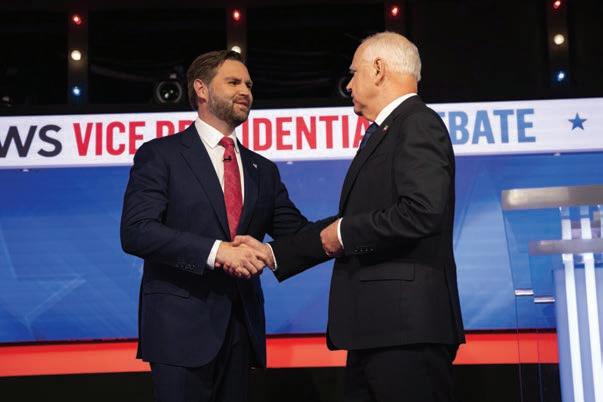
This week at Wabash
Saturday, Sep. 5
7:30 p.m. | Tartufe @ Ball Theater

Monday, Sep. 7
6:00 p.m. | Bending the Arc @ Hays 104
Tuesday, Sep. 8
7:30 p.m. | Glee Club Fall Concert @ Salter Hall
Thursday, Sep. 10
All Day | Midsemester Break!

301 W. Wabash Ave., Crawfordsville, IN, 47933
X: @bachelorwabash
IG: @bachelorwabash
EDITOR-IN-CHIEF
Sam Benedict • ssbenedi25@wabash.edu
MANAGING EDITOR
Logan Weilbaker • laweilba25@wabash.edu
NEWS EDITOR
James Wallace • jpwallac26@wabash.edu
OPINION EDITOR
Preston Reynolds • pcreynol25@wabash.edu
FEATURES EDITOR
Nathan Ellenberger • nvellenb26@wabash.edu
SPORTS EDITOR
Ethan Wallace • ewallac25@wabash.edu
PHOTO EDITORS
Elijah Greene • eagreene25@wabash.edu
Will Duncan • wjduncan27@wabash.edu
The purpose of The Bachelor is to serve the school audience, including but not limited to administrators, faculty and staff, parents, alumni, community members and most importantly, the students. Because this is a school paper, the content and character within will cater to the student body’s interests, ideas, and issues. Further, this publication will serve as a medium and forum for student opinions and ideas.
Although an individual newspaper, the Board of Publications publishes The Bachelor The Bachelor and BOP receive funding from the Wabash College Student Senate, which derives its funds from the Wabash College student body. Letters (e-mails) to the editor are welcomed and encouraged. They will only be published if they include name, phone, or e-mail, and are not longer than 800 words.
The Bachelor reserves the right to edit letters for content, typographical errors, and length. All letters received become property of this publication for the purposes of reprinting and/ or redistribution. Profanity may appear in the publication, but only in cases of direct quote or if profanity is necessary to the content of the story. Please do not confuse profanity with obscenity. No article or picture of an obscene nature will appear in this publication.
The Bachelor is printed every Thursday at the Purdue Exponent in West Lafayette. It is delivered freely to all students, faculty, and staff at Wabash College. All advertising published in the Bachelor is subject to an established rate card. The Bachelor reserves the right to deny requests for publication of advertisements. Student organizations of Wabash College may purchase advertisements at half the listed rate.
The Bachelor is a member of the Hoosier State and Indiana Collegiate Press Associations (HSPA and ICPA).


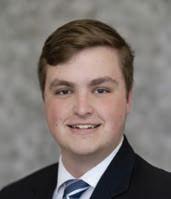
IJacob Weber ’25
Reply to this opinion at jtweber25@wabash.edu
f there’s one thing that should be abundantly clear to anyone in the Wabash community, it’s that great leaders have and will continue to graduate from Wabash College. Whether it be leaders in the law, business, medicine, the arts or any of the other careers which a Wabash man may find himself, we tend to find our way into all the right places to make an impact on the lives of those around us. So, what makes Wabash so adept at developing young men into leaders?
First, our classroom experiences shape us into men who can think critically and actively listen to those around us. Discussion based classes help empower everyone to know that their input matters in the decision-making process. This is especially important for those who leaders collaborate with. Leadership is impossible without having collaborators around you who are committed to the work of a collective. While many would call these collaborators “followers,” that simply is not the case.
A leader is inept without their ability to rely on their collaborators to help get things done. Wabash’s academic experiences help empower those who do not hold titled positions of leadership to be active in the decision-making process, strengthening the collective as it strives to be the best it can be.
Second, formal experiences such as the Leadership Education And Development (LEAD) program are a great place to start.
Associate Dean of Students Marc Welch started the program in the Spring of 2021, and since then it has involved more than 100 students from across campus. While forming quality leaders is rarely achieved in lecture halls or classroom settings, leadership development programs like LEAD provide us the opportunity to develop a theoretical background in what makes a person an effective leader.
But theoretical knowledge can only go so far though, so it must be supplemented by the third part of Wabash that makes us
great at producing leaders: experience.
Nearly every Wabash alumnus I interact with has pointed to lessons learned outside the classroom as just as valuable as their actual degree, if not more. Learning how to work with a group of others and working through disagreements when things get rough are key skills to have for anyone in a modern world.
Learning through doing is the best way to hone these skills. While everyone is destined to slip-up at one point or another, positive leadership cultures encourage leaders to learn from their mistakes and continue on a path for a better future.
Like many other fraternity men, I’ve learned far more about leadership through my own chapter than any other experience. Leading a group of college students is no small feat, and yet each of our fraternities on campus are recognized as key institutions for developing leaders on campus and in our futures. While one of the most common examples on campus, fraternities are not the only place to learn to lead.
Getting involved in clubs and campus organizations, having a Wabash Internships and Student Employment (WISE) job and being someone others depend on are just some of the many key ways to learn leadership skills through practice. Some of the most influential leaders in any organization are those without titles, so never discount the contributions of yourself or others simply because of a title or election. Don’t neglect these formative opportunities just because it is easier to stay in your room or let someone else do the work for you. Instead, be an active contributor and focus on growing yourself as a person and a leader in your four years at Wabash.
Lastly take all the lessons you learn here into your future careers and lives. 20 years from now your approach to leadership will be vastly different from that which you have today. However, it is never too early to start learning how to be a leader in your own right.
Learn to be comfortable being uncomfortable, and put yourself in a position to learn from those around you who you see as successful leaders. The only person who can do the work of making you a better leader is yourself. And never forget that whether in a boardroom, community organization or another avenue, we have a duty to take our experiences from this campus further than Crawfordsville.

FIVE THINGS WORTHY OF A HI-FIVE THIS WEEK PACKAGE INTERCEPTION OVERTURNED
Low-five to Chiefs WR Rashee Rice’s mom, who was arrested for stealing her neighbor’s packages. After reviewing the play, it is now a penalty on the neighbors.
Hi-five to the Tigers and Royals for sweeping their games in the Wild Card Series. Bring out the brooms and hide the trash cans.
Low-five to a certain pickle-related club for not sending out an email over the weekend. We found ourselves lost in a desert without the sage advice of our briny bretheren.
Low-five to mother nature for spliting Delt’s 200-year-old tree in half. The skies are not clear rhynes. I repeat, the skies are not clear.
Hi-five to Dr. Dunaway’s cat, Hank, for stealing the rhyne Pots. With rugby finally getting a coach, if construction starts on Sparks the ultimate parlay will hit.
James Szalkie ’25
Reply to this opinion at jwszalki25@wabash.edu
olly Rancher recently unveiled their newest creation, joining the ranks of other rope-themed candies. A market originally cornered by Sweet Tarts has now opened the floodgates to other follow-up attempts, turning this into a modern classic of desserts. However, Jolly Ranchers’ take on this contemporary confectionery left much to be desired.
Biting into it, the first thing that struck me was the odd mistranslation of the classic Jolly Ranchers recipe. Unfortunately, they ventured into the dreaded “cough syrup” zone that many candy manufacturers stumble
into during early drafts of their products. It left a sickly taste on the tip of my tongue, like fruit plucked far too early from the earth, before it could offer a tearful goodbye.
The only remotely redeeming flavor was the apple variety, which reminded me a little too much of the applescented, tear-free children’s shampoo my sister and I used in our youth.
The blue raspberry flavor, however, was an insult to the classic “blue” flavoring that defined my adolescence— those long, hot summer days filled with the sweet delight of Airheads, Sour Straws and Sour Patch Kids, all purchased with my lawn-mowing money. This new take was nothing but a warped misrepresentation of those fond memories, like an old family photograph that has yellowed and distorted with age. Watermelon was alright.
Another element that stood out was the texture. While successful takes on the rope genre often feature a chewy exterior with a creamy filling reminiscent of the popular Midwestern “Cow

Interested in featuring your art in the Bachelor? We are looking for new artists to be consistently featured in the Opinions section!
Are you interested in making comics? Do you want your art to be featured in The Bachelor?
Contact pcreynol25@wabash.edu or ssbenedi25@wabash.edu
Tails.” The Jolly Ranchers’ exterior was more gummy, lacking the powdery coating that many in the rope-candy craft have come to expect. This coating typically offsets the sticky nature of such treats.


The flavor of the filling also caught me off guard. Rather than using a neutral, cream-flavored filling, Jolly Rancher doubled down on the sickly sweet flavor found in the exterior. This overload of sugar, corn syrup and red-dye forty was more than enough to turn my stomach. It felt like a wrestler’s dehydrationinduced fever dream of how a Jolly Rancher might taste. And at over four dollars a pack, these are a sure miss the next time you’re at the supermarket. Unfortunately, this one needs to go back to the drawing board.


Connor Craig ’25
My teammates and I got a nice date with the Class of 1950 Natatorium all fall break. De**** doesn’t know about grit like that though.
Nicholas Green ’27
I’m remaining on-campus for break, so I plan on catching up on sleep and exploring Indiana with my fraternity brothers.
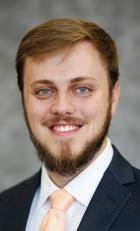
WLogan Weilbaker '25
Reply to this
abash boasts the second-best alumni network in the nation. I believe it. I’ve met with alumni in Indiana, Ohio, New York, Missouri, Connecticut, Maryland, California and the Czech Republic — all of whom were excited to get to know me and offered words of support for my future.
It’s no wonder Wabash students, faculty, staff and alumni push students so hard to network. Even the freshmen, in their short time at the College, have already heard multiple addresses from the Chapel lectern stressing the importance of increasing the size and quality of your social network.
“Don’t be afraid to reach out to alumni,” they say. “Leverage your connections. Ask for support. Don’t be worried if the first alum you talk to doesn’t offer you a job. Maybe he’ll introduce you to someone who will.”
The concept of networking is inherently self-centered.
When you say “I want to network with this person,” what you’re really saying is, “I want them to help me.” Humans are indeed made to form relationships with one another, but that does not mean human relationships are made to be leveraged.
For nearly two centuries, we’ve sustained a belief that humans evolved due to “survival of the fittest.” This is false. Individuals have certainly stepped on backs to elevate themselves above others, but we, as a species, rose to the top of the food chain due to our ability to work together and form communities.
Lions in a pit will eventually get hungry and one will eat the other. Humans in a pit will work together to escape.
When we view the people around us as nothing but proverbial rungs on a corporate ladder, we revert to our basest primal instincts. As animals, it is very much in our nature to put ourselves first, but it just isn’t beneficial in the long run.
Jacob Weber ’25
I’ll be working on moot court prep as to not disappoint Professor Scott Himsel and Jane-Ann Himsel.
Ryan Frazier ’26
I’m going to go home and see my family. My brother is home for four weeks from the Marines. He’s been in Haiti, so I’m seeing him for the first time in a while.
Instead of building your network, my hope for you, reader, is that you increase the size and quality of your community.
The two are similar, but I suggest the difference lies in how we perceive the support systems in our lives. Envision a network like a wheel, with you at the center and spokes branching off — spokes that can get you a job, promotion or development opportunity. By lengthening your spokes, you enable yourself to cover more ground more quickly.
Envision a community like the foundation of a building, where you are but one brick, connected by mortar to those around you. In this example, you’re not at the center — it’s not about you. When you engage with and strengthen your community, you help cultivate an environment where others can grow.
The success of a network is measured by your personal progress, but a community is measured by what is born of it. Upon a strong base can be built things like art, philanthropy, mutual understanding, involvement and yes, even personal opportunities, though that isn’t the goal.
When you invest in the community around you without expecting some direct payout from it, you might just be surprised at the benefit you will receive.
As a “brick” in a community, you may not go anywhere, but you might learn that where you are is a worthwhile place to be.
This leads to my final point: Invest in a community you care about. Don’t like the place you grew up? Don’t love Wabash as much as you thought you did?
Never found a fraternity where you felt at home? That’s fine. One of the great parts about being a young, educated person in a free country is that you can choose to commune wherever and with whomever you please.
Don’t just get involved, however, for personal gain. Get involved because you see the value in the people, programs and places in your community, and because you have a desire to play a role in the development of those facets. You are valuable! What you can offer to your community is valuable as well.
Life is about more than just a race to see how far you can get ahead of your peers. If you’re doing it right, life should be an effort to see how far we all can get when we work together.
Brady Largent ’26
I will be running to the polls this midsemester break (along with sleeping for an inhuman amount of time). I hope my Wabash brethren will join me in early voting this election season!
Makana Edwards ’28
I hope to return home over break. Otherwise, I’ll be staying with football!


Jennifer Merrell
As seniors, you’ve now executed a solid college strategy, ensuring you’ve not only learned the technical skills and got the grades but acquired practical work experience to qualify for your first real job. You’ve researched the company and the hiring manager. You’ve been to mock interviews, you’ve polished your resume and you’ve ironed your shirt. Now what?
Storytelling is the piece that pulls it all together. It is a powerful tool that will help you stand out in a job interview. By sharing the relevant anecdotes from your past experiences and relating them to the job you are interviewing for, you can illustrate your skills, qualifications and value to an employer. (1) Practice your stories ahead of time. Write them down and be prepared for follow-up questions. (2) Keep your stories concise, relevant to the position and focused on your positive attributes.
Showing you have experience solving complex problems and using critical thinking can help tackle two top skills employers in every industry look for. The third? Communication (and that will come through in a well-articulated story). Remember, the goal is to engage the interviewer and leave a lasting impression.
Evaluating Compensation. If you are fortunate enough to have multiple offers or offers in a few different states, you need to compare apples to apples. Even if you only have one job offer, you still need to understand “total compensation”.
Total compensation is the full benefits and compensation package an employee receives. This includes your salary, bonuses, stock options, health insurance, 401k and other employer contributions.
Why is this important? Salary alone does not paint the whole picture. Even if it did, the cost of living alone would take $100,000 in San Diego to equal $64,573 in Indianapolis (nerdwallet.com). But salary alone doesn’t tell the whole story. Here are a few other components to consider:
Health Insurance: An employer paying 100% of your medical insurance premiums vs. an employer offering you group medical insurance (at your cost) is a value of nearly $400 a month or $4800 a year in compensation (Forbes.com).
Retirement plans: With a salary of $50,000, an employer with a 10% match is the difference of $5,000 more a year in compensation vs. an employer just offering the option to participate in a 401k.
Financial responsibility means being accountable for your financial well-being. This goes well-beyond paying your bills. This includes creating a budget, investment goals for your future, managing student loans alongside expenses you may not have incurred as a student, saving for unexpected repairs or health costs. It is making informed spending and debt decisions. Why is this important? Financial responsibil-

Will return on October 18 with another issue
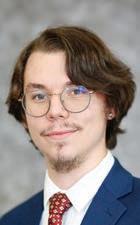
Logan Fleming '25
Reply to this opinion at ljfemin25@wabash.edu
Wabash is a unique place, it is a college that serves young men and builds them up to participate in the world. The fact that we are all male is sometimes a disadvantage, for example, class discussions can be limited by the fact that there is no feminine perspective or solely the feminine perspective of a professor.
However, I would contend that being an all male school is primarily an advantage. I feel like the professors here encourage the development of our masculinity in a way that builds us up. But to build up healthy masculinity we must be intellectually humble enough to acknowledge when being masculine fails us. Rejecting hypermasculine behaviors will reduce the stigma surrounding emotional availability, fear of weakness and reduce the compulsion to always project toughness.
I do not mean to say that rejecting hyper-masculinity would make us perfectly empathetic and vulnerable. Still, instead of feeling societal pressure to conform to rigidness, we are allowed to be more open with our emotions because of quality peers and professors who engage us to redefine our perceptions of what it means to be a man. Of course, there are still hyper-masculine men. Men who define themselves not by what they are, but by what they are not. Meaning that they center their masculine identity around the rejection of feminine behavior.
If you are not sure if you fit in that category, ask yourself whether you are scared to be perceived as feminine or if you see men expressing emotions as “sissies.” I do not think any man should be scared of being perceived as feminine, but, unfortunately, we live in a society where shame envelops men who express their emotions. There is a time and a place for emotional toughness and there is a time and place for vulnerability.
Finding the balance is a part of every man’s journey. Wabash, but college in general, is the place for young men to find that balance and develop an understanding of how they incorporate masculinity into their daily lives. But beyond that, college is the place where young men and women develop their core beliefs and find their purpose. Something that I think about a lot is that everyone has deep core beliefs, deep aspects of their being that formulate their identity. What we see in classrooms or social events is only a fraction of someone’s true self. We make assumptions about our peers constantly, we hear a comment in class and construct our percep-
ity creates the foundation for a secure financial future. Budgeting and saving will help new grads avoid debt, build a strong credit score and work towards long-term financial goals. This provides for more choices and flexibility in life, reduces financial stress and will enable you to focus on your career and personal growth.
Top Tip: A credit card is not your money. If you don’t have the money to buy those new shoes or go on a vacation to the islands, don’t. You will have those things and go to those places when you do have the money and, for most people, that will be a little later in your career. Put together a 3-5-10 year financial plan to work towards the goals you have (which could be that vacation to the islands, but should also include maxing out your 401k each year).
If these or any other financial considerations are something you want to explore more in depth, your career services office can help.
Now, remember the “Magic Number Two.” Congratulations, you’ve landed your first job! Now stick with it for two years.
I’ve lived in three states, six cities, and 10 homes. It takes about two years to find good friends and a feeling of belonging. I’ve worked in three industries and eight companies and found that it takes about two years to learn the business, navigate the culture, and master the role.
I’ve seen too many new grads quit their first job within the first year. Unless your mental, emotional or physical health is truly being jeopardized, don’t quit. Because you “don’t like it” is not really a good reason. Stay two years.
Build qualifications. Two years is enough time to learn new skills and build qualifications to include on your resume.
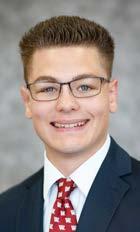
tions of their world beliefs. We see social media profiles as projections of the self, true representations of who someone really is. Why bother with all that? No matter how well you may know someone, you will not truly know their core beliefs unless you ask.
For the sake of example, let’s talk politics. Political alignment is a continuum, you may be far left, far right, dead center or anywhere in between. However, just because you lean one way does not mean you always think with that alignment. It may be more likely, but to assume that you understand someone’s entire political perspective because of their perspective on a singular issue is nonsensical. Identity is the same way. You may get glimpses into an individual’s true self but to assume you truly understand them is foolish. Instead of playing a guessing game, we need to develop mutual understanding and empathy. It may be easier to judge people based on preconceived notions than to sit down and have a deep conversation with them. In my mind, Wabash is at a higher standard. This is both a good and a bad thing. It is good when people meet that standard, but it is not surprising that some do not. It is good when I see people in pursuit of true mutual understanding, an understanding that is influenced by curiosity and genuine care for your fellow man.
But Wabash is not perfect and sometimes individuals pursue understanding with bad intentions. In the worst case, they forgo seeking understanding at all and write people off before giving them a chance, and in others, they use people for personal gain. Or they are so fixated on the hyper-masculine that they are unable to have deep conversations unless libations are involved and even then you only get small glimpses through the cracks in the shell.
Too often I have heard my Wabash brothers belittle others for being different. We all love to joke around until the proverbial gun is pointed at our head. Maybe you are not sensitive, maybe you have thick skin and maybe you are a true man’s man. But to assume that others are just as tough as you could lead to social blunders.
However, the problem with a social blunder like this is that people get praise for it in the form of laughter. There is a lot more work to be done untangling the web of masculinity and empathy, and I hope that mutual understanding can play a pivotal role. I do think that Wabash is amazing, and being an all male school helps us redefine what it means to be a man but more specifically a Wabash man. It starts with us though, we must point out pointless belittlement even if it is addressed to people we do not know. We must stop judging and assuming things about people based on limited information either seen or heard through glimpses or rumors. We must ditch hyper-masculinity and become comfortable with vulnerability.
Build relationships. You can build relationships with other employees in your field. Show dedication. Staying at your first job for at least two years can show that you’re dedicated to a job. Be a good reference. The longer you stay at a job, the better it will look as a reference. You’re going to want a good reference from your current employer.
That being said, if you do want to make a change, make a plan first. Explore what you want to do next, network in that industry, learn the skills you may be lacking outside of your current working hours and prepare yourself to land a new job before you quit your current job.
Overall, two years will give you the experiences you need to be better qualified for your next stop while showing the next employer that you are worth the investment.
Landing that first job is just the beginning. It takes time to build skills and experience, develop and grow relationships and demonstrate your dedication. While you’re there, take the opportunity to learn more about yourself and what you want in your career. Use this knowledge to make informed decisions about your future. And if the first job is not everything you dreamed of....you’ll be preparing to land your dream job down the road.
Editors note: Jennifer Merrell is a Chair for the Digital Fluency Advisory Council of Franklin College.
Gavinn Alstott '25
Reply to this opinion at gdalstot25@wabash.edu
It’s getting to the point in the semester where classes are picking up, sports are getting more involved, rhyneship is in full swing and suddenly we are finding ourselves cloistered in our rooms to work on projects on the weekends. So, I want to invite everyone to keep this in mind: stay connected to the type of Wabash you want to experience.

What I mean is that you do not have to forsake your expectations of Wabash this year because you find yourself in an undesirable situation. Although this seems more philosophical than practical advice, I believe it provides an important perspective we all can abide by. What prompted this opinion you might ask? The recent lack of attendance at senior bowling night. It was a measly fivepercent of the entire senior class that met at the beloved Plaza Lanes. It led me to make one of two conclusions: either Wabash’s senior class is antisocial, or we are just a bunch of walking zombies. Although these are both undesirable labels, I think I lean toward the ladder.
When I say “walking zombies” of course I don’t mean it literally, but I am saying that we have become possessed by our daily routines to the point that we are losing sight of our broader Wabash experience. We are moving through the days on autopilot because of our busyness. But, we need to be careful signaling we are busy to our peers because we might miss out on evening plans or a way to extend a helping hand.
The words “I’m busy” have become an abhorrent catchphrase that nobody should be proud of. We are buried underneath our stress, our screens and sometimes taken to the extreme: our studies. I think too often we as men feel self-pity, rather than boldly confronting the problems that are undermining our health. Although Wabash is not supposed to be easy, I am beginning to rethink what this really means especially in the context of the ongoing struggle of men’s mental health.
Just a couple of weeks ago, Leslie Weirich shared her testimony about her son who took his own life while on campus, and it was very emotional and eye-opening. She talked about the importance of real live human connection that is essential for everyone’s mental health, and the tragic outcomes that have resulted from a lack thereof. She recognized that we have 70 diverse student clubs on campus that represent a wide variety of interests and opportunities that students should take advantage of.
We should be proud of this, but we should recognize where we fall short. For instance,
the addition of the 4th credit hour has thrown a wrench into these extracurricular activities.

Although some students seem unaffected by the 4th credit hour others seem to be barely keeping their head above water. The differential standards that are being set by professors with regards to the 4th credit hour can become too overwhelming for some students who value organization. In addition, the 4th credit hour has certainly increased the workload without preparing men to effectively manage their time. This is something that needs to be discussed and properly implemented before it undermines our mental health.
In the year 2000, American political scientist Robert Putnam published a book titled Bowling Alone: The Collapse and Revival of American Community. Putnam showed how we have increasingly become more disconnected between our family, friends and our democratic institutions. His work has been widely cited in many scholarly sources for good reason, and I encourage everyone to check it out if they haven’t already. It seems to me that even at a college campus ripe with tradition and community, we are still not exempt from Putnam’s warning.
I think we should be open about finding solutions to these problems, but I have a couple of suggestions:
First, talk to someone you know before entering a high stress situation such as an exam or interview. This will calm your nerves, so that you can be mentally prepared to put forth your best effort. Perhaps you can call home every once in a while, too, to tell your parents about what you have been up to, they would love to hear from you.
Second, go to an event on campus to decompress and relax. It could be anything, but it needs to be something that will not feel like there is a ton of pressure. It could be a club or an event that you usually don’t go to, but you might have the opportunity to learn something new and to break out of your normal mundane routine that is dragging you down. It will make you appreciate the community that makes Wabash special without feeling like it’s a chore all the time.
Lastly, seniors must step up to the plate. We must embrace our leadership roles and lead by example, so we can truly model what it means for others to enjoy the Wabash experience. You can work diligently on your senior capstone project or on perfecting your future job application, but one day we will never get the chance to make memories at Wabash. For me, that was what drew me to Wabash in the first place, and I know that many seniors have to feel the same way.
The moral of the story is simple: don’t be a walking zombie, start loving the brotherhood the way you meant to. We are at a place that values identity, it’s time to form the identity you truly want to have. But like any good leader, we should not dwell on our past outcomes that have missed the mark. We still have a lot of time left in the year to build the events and relationships we seek to cultivate. Stay connected Wabash.
Are you interested in making your opinions known? Serious, silly, political? We want them!
If interested, contact pcreynol25@wabash.edu

Orgon (Professor of Spanish V. Dan Rogers, left) cries out to Mariane (Isabella de Assis-Wilson, center) during a dress rehearsal for "Tartuffe" on October 1, 2024 in Ball Theater.
CHRIS BOARD '27
GUEST WRITER
The Wabash Theater Department rang in a new season with the fall production of “Tartuffe.”
The comedy by French playwright Molière was originally condemned as sacrilege and blasphemy by King Louis XIV, but the audience on opening night had nothing but praise for the modern production.
Upon entering Ball Theater, the audience is greeted by an elegant mansion, decorated with statues, a large doorway and a towering staircase.
A pattern of light pink marble decorates the foor and stairs that is meant to resemble the original Lilly Library foors. The backdrop is set with portraits that sneakily resemble the actors of the show to envelop the audience in the household ambience.
The set, designed by Technical Director David Vogel
and Scenic Charge Benjamin High ’24, welcomes the viewers into the chaotic and comedic happenings of the main family. When the troublesome titular Tartuffe (Alex Schmidt ’27) begins his charade, the family has disagreements on how to best handle the situation. Orgon, the patriarch and father of the family as depicted by Professor of Spanish V. Daniel Rogers H’12, is in total favor of Tartuffe, praising his pious ways and religious demeanor. His mother Madame Pernelle, played by Fine Arts coordinator Julia Phipps, supports Orgon’s beliefs and attempts to infuence the rest of the family to agree as well. Daughter Mariane (Isabella de Assis-Wilson), son Damis (Eamon Colglazier ’28), maid Dorine (Delada Mudd) and brother-in-law Cleante (Carson Wirtz ’26) all believe
something is amiss with the supposed saint. When Tartuffe makes moves on Orgon’s wife, Elmire, who ironically is played by Rogers’ wife, Jill Rogers, she becomes skeptical of the man’s true intentions. Things go downhill when Tartuffe pulls a fast one on the family. Monsieur Loyal (Xavier Master ’28) announces to the family that they are to surrender the power of Tartuffe. Eli Reeves ’25 barges in as Valere, Mariane’s fancé, to urge the family to act while they still can. Their attempts are foiled by a dramatic entrance from Tartuffe and an offcer of the court (Preston Parker ‘26). As events unfold, the safety of the family is up to chance.
The script of the play is outlined in a rhyme scheme that provides rhythm and a little predictability to the show. However, it is evident

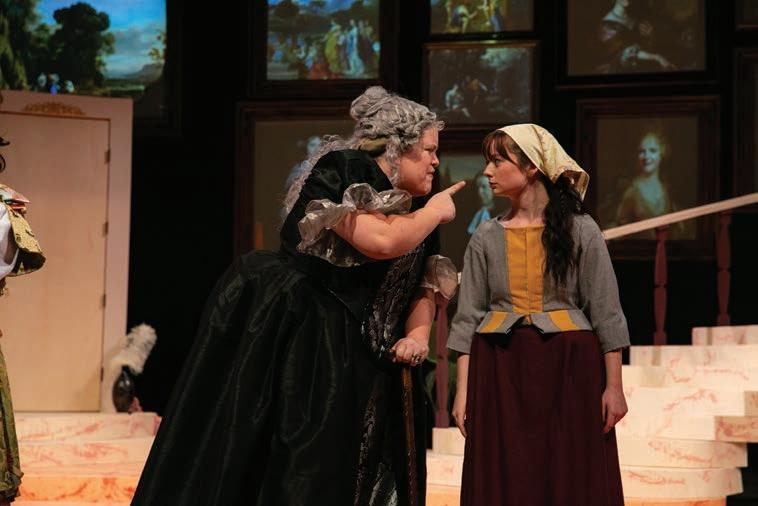
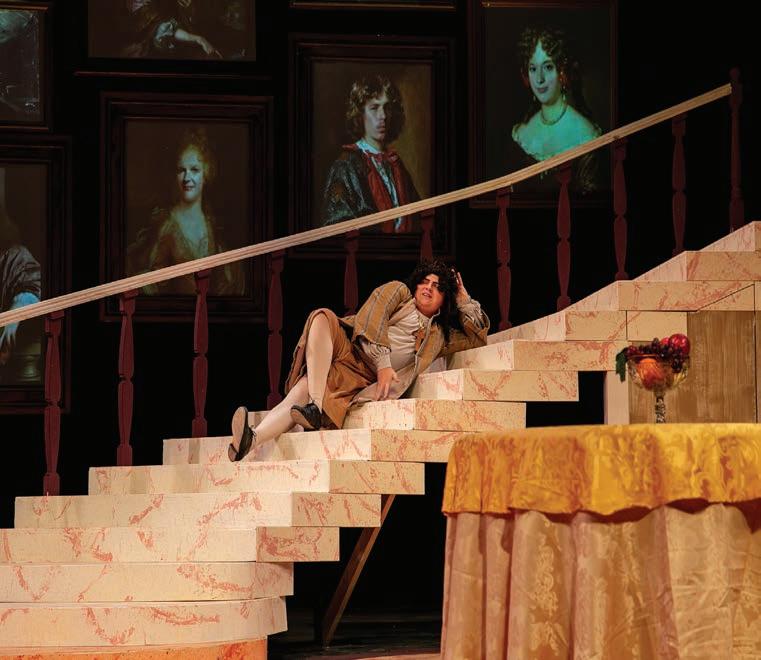
during some points of the play that the actors recognize the pattern as well. During some scenes of the play, emotions are lost to the efforts of the actors remembering the rhymes within their lines. Whether it was opening night jitters or the writing of the play that caused such disturbances is hard to say.
But when the comedic moments of the show desperately needed air,

the cast landed them perfectly. Dirty firting between Tartuffe and Elmire had the crowd dropping their jaws and clinging to their chairs.
The whole expanse of the stage is utilized through blocking of director James Cherry and encourages the audience to take it all in.
Do not be fooled by the seemingly ancient origins of “Tartuffe.” The Wabash cast provides a production that would have even the

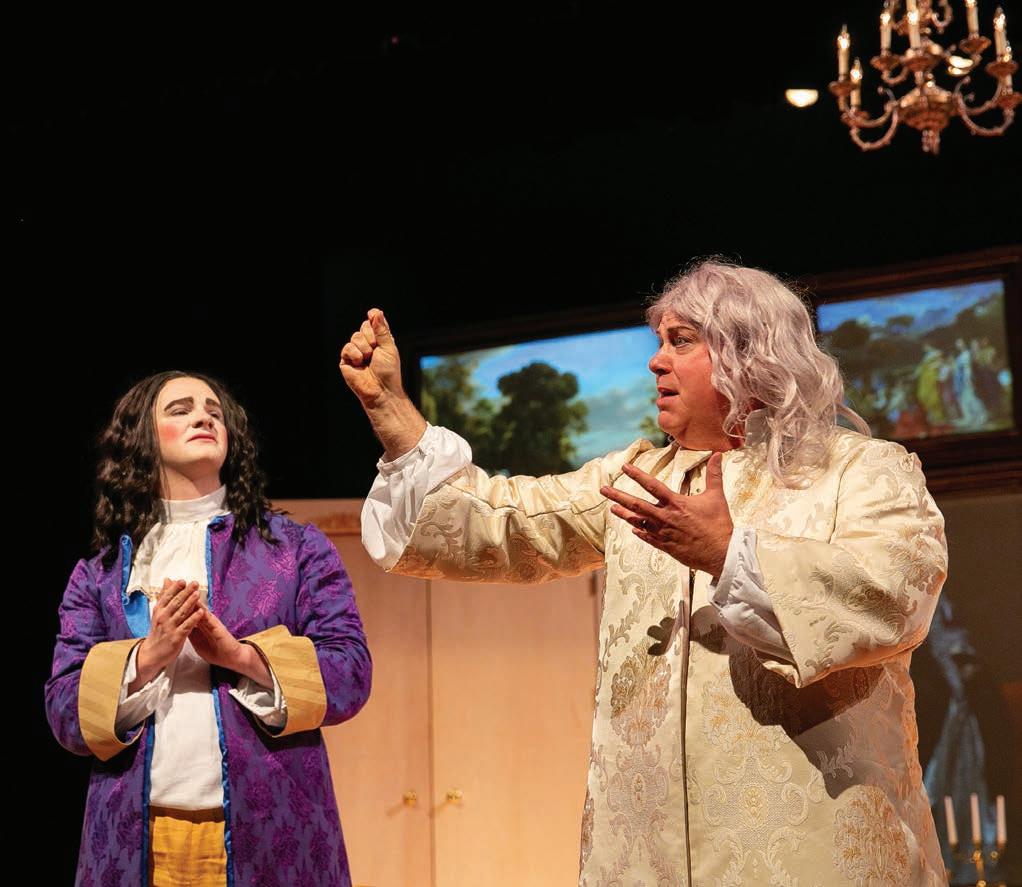

Archbishop of Paris on their feet. Dramatic and critical monologues paired with amorous scenes of courtly love promise theater patrons a night full of laughs and rhyming fun. Buy a ticket, and fnd the proof. In the next two days, go see “Tartuffe!” Tartuffe runs October 2–5, 2024 in Ball Theater. Free tickets can be reserved online at wabash.edu/boxoffce.



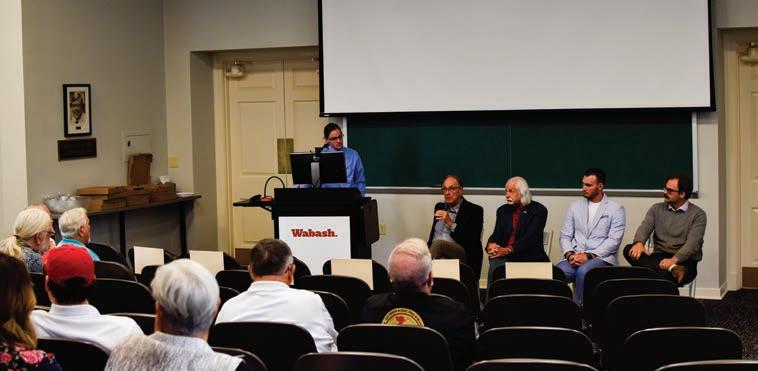
PRESTON REYNOLDS '25
OPINION EDITOR
“Why is history worth remembering?”
That was the question of the day as Wabash College welcomed back two alumni and a former professor for their panel “Remembering Vietnam: Memory and Memorial.” Former Wabash history professor
Sabrina Thomas, who gave the introductions of the panelists, was accompanied by her colleague at Texas Tech University, Professor of History and Executive Director of the Institute for Peace and Confict (IPC) Ron Milam.
Rounding out the panel was Professor of English Emeritus Tobey Herzog H'11 as well as Austin Bryant ’23 and Ian Little ’20. Both professors Herzog and Milam served in the Vietnam war, while Bryant and Little were prominent students in Professor Thomas’ Vietnam oral history project.
Both students shared their
experience on the panel, while the veterans spoke on the wider impact of oral history. Bryant described how the oral history project matured his interpersonal skills to prepare for a career in law enforcement, saying “not many people our age know how to sit down and talk with a person, to really listen and record their experience.”
For Ian Little, the oral history project gave him an opportunity to engage with history in a unique way.
“I was a theater major at Wabash, but being able to sit down and listen to someone’s story really touched me,” said Little.
Little emphasized the impact of empathy in oral history saying that “seeing how these veterans were impacted by our work felt very important.”
Milam had plenty of praise for Wabash’s oral history project.
“Very few other institutions do this. You folks are doing a great job here.”
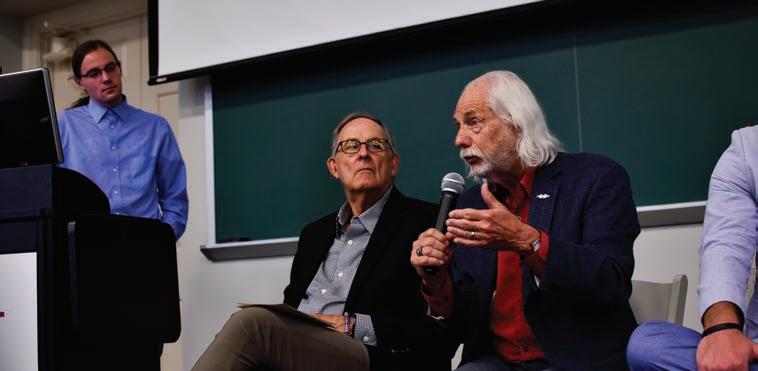
Milam also has returned to Vietnam more than 15 times as an ambassador and educator.
“There are still 300,000 missing Vietnamese dead in country.,” said Milam. “Texas Tech is the only university that is trying to recover American, North and South Vietnamese bodies.”
Earning his Ph.D after more than 20 years in the oil and gas industry, Professor Milam brought a unique perspective to the panel. He shared some of his experience as a middle-aged graduate student and veteran.
“Everything they talked about regarding Vietnam was as if it happened in Washington, Hanoi or Saigon,” said Milam. “There was no talk of soldiering.”
On a visit to Carlisle Barrack in Pennsylvania, Milam found that they had more oral history accounts from the Spanish American War than the Vietnam War.
“Vietnam vets weren’t really interested in telling their stories until recently,” said Milam.


“There’s a misconception that soldiering isn’t ‘important’ unless you were a combat offcer. That’s untrue. All soldiers were in danger in Vietnam.”
Professor Herzog agreed, adding that, “the Vietnam War’s importance to our nation has shifted in recent years.”
When he started his career in Vietnam War literature, very few scholars were focused on the individual experience of soldiers themselves, which is something the world has seen change in recently.
Professor Milam built on this by applying the history to the current treatment of returning vets.
The perceived reality plays as much role as the actual reality, with a majority of the country showing ambivalence towards veterans coming back from Iraq and Afghanistan.
Certain veterans present at the panel were disgruntled with the panelists’ focus on only positive reactions of interviewed
veterans, claiming that many veterans across the country were still angry.
Professor Herzog responded, stating that, while early in his career he encountered many frustrated veterans, most of the subjects now are willing to share their stories.
“For oral history projects, we fnd our subjects through public forms or veteran’s associations,” said Herzog. “Those veterans are usually looking to make peace with their experience.”
“Remembering Vietnam” concluded with a ceremony where Wabash Archivist Nolan Eller ’11 exchanged the oral history recordings with Professor Milam for a plaque of appreciation. As the room emptied out, Bryant and Little smiled, exchanging words with various veterans, in addition to their families, excited that their memories will live through oral history.

NOAH TAYLOR '28 STAFF WRITER
Wabash has a plethora of new faculty this academic year, with 20 new staff members joining the roster. Among the new faces in the modern languages department is Visiting Assistant Professor of Spanish Patrick Kozey of Indianapolis, Indiana.
Professor Kozey graduated from Stanford with a degree in Spanish, then moved onto graduate school at Cornell. Professor Kozey has prior experience teaching at Wake Forest and Austin College. He attributes his experience at Austin College as something that motivated him to apply to Wabash.
“I’d always been more interested in teaching at a small college,” said Kozey. “I was at Austin College last year, Wake Forest the year before that, and it was a good reminder that this was the kind of thing I wanted to be doing.”
Associate Professor of Spanish and Senior Associate Dean of the College Jane Hardy had nothing but great things to say about her new colleague. Citing his great domestic and international work experiences, she listed his other qualities that explained why he was hired on.
“I’ve been working closely with him so far this semester,” said Hardy. “He’s really easygoing, pleasant to work with and a great team player.”
Teaching style is a big deal here at Wabash. Kozey certainly fts the bill of an ideal Wabash professor: Someone who can connect with their students, be energetic in the classroom and contribute to a great education.
Dean Hardy describes him as energetic, dynamic and learner-centered in the classroom.
“Students are not just learning about the language, but they are really learning to use it,” said Hardy. “Ultimately that is what we want.”
One thing that has grabbed Kozey’s attention so far during his time at Wabash is the sense of community the students have not only built for themselves but also for the institution as a whole. He notes that some of our longstanding traditions show similarity to Stanford, his undergraduate institution.
“I’ve been really struck by how good a job the College and the student body does at creating an actual sense of community for each other,” said Kozey. “That’s pretty unique, I haven’t been to many places that seem as focused on that.”
Dr. Kozey has several longterm projects. Among them are not only courses he would like to develop, but a book project and some articles he is authoring as well. He is technically a visiting professor at the moment, so a long term stay in Detchon might not be in the cards for Kozey. However, he is excited about teaching a course on Spanish crime fction next semester. Kozey says students should want to take his classes not only if the topic sounds interesting, but since they provide a solid environment for developing language fundamentals. Kozey has a true passion for helping students read, write, communicate and form valuable connections with speakers of the most popular language in the world.

Down
1. "___ Wednesday"
2. "I Like ___" (presidential slogan)
3. Like some musical keys: Abbr.
4. Unassisted
5. Mandarin and Valencia
6. Bleacher creature

OPINION EDITOR
Wolfgang Amadeus Mozart (1756-1791), the famous child prodigy and much-hyped musical legend known for his bombastic symphonic and operatic pieces, has ingrained himself in world musical tradition. Achieving almost unmatched fame, he went out at a young age just like Jimi Hendrix or Kurt Cobain.
Though many thought Mozart’s music career to have ended with his 1791 Requiem in D-minor, Amadeus has come back in a big way. His newly dropped deep-cut, Ganz Kleine Nachtmusik (K. 648), has stunned an unexpecting public.
*Governor (1811 – 1881) 19. 22-mile-high layer 20. Fe, to a chemist 21. Premiered, as a play 22. Ballet birds 25. Music class? 28. Right, on maps
29. *Author (1827 – 1905)
34. Superlative suffx
35. Judge's assignments
36. Rides to the Oscars
37. Jessica Parker and Michelle Gellar
39. Swanky vacation spot
40. Badmouth
41. Popular sideline headwear
44. Post-anthem chant
45. *Cruciverbalist (b. 1952)
47. Be a worrywart
48. Pisa's leaner
49. Thanksgiving Day chore
50. Rain Man, e.g.
54. Middle name for Jimmy Carter
56. 5-7-5 poem
57. *Astronaut (b. 1937)
62. Path of Earth
63. Chip in, literally
64. "The Aeneid," for one
65. Those between 12 and 20
66. Rolling stones don't gather it
67. Partner of Snap and Crackle


ALEX SCHMIDT '27
STAFF WRITER
The dark Peacock documentary, “Gary,” will make you scratch your head and leave you truly speechless. “Gary” is a documentary flm, just around two hours, that dives deep into the life of child star Gary Coleman, who died mysteriously.
Coleman was well known in the late 80s and 90s for his role as Arnold in the show “Different Strokes.” Coleman, who suffered from a kidney disease that stunted his growth, found success because of his acting talent and impressionable personality. This documentary shines on his fame, while the main focus is that Gary Coleman was murdered by his ex-wife. The documentary is especially chill-
7. Hoppy quaff
8. Child's hat topper
9. Take life easy
10. "like ___ of bricks"
11. Third perfect cube
12. Word with "steel" or "pigeon"
14. Ctrl-P command 18. 12 mos.
21. 60 minuti
22. Lever-and-fulcrum playground fxture
23. Sushi condiment
24. Starry?
26. Source of Manchego cheese
27. Meteorologic org.
29. "Deck the Halls" syllables
30. Fleur-de-___
31. Affaires de coeur
32. Old-time shapewear
33. It's willed in a will
35. Equestrian's favorite snack?
38. Language nobody speaks?
39. "Monsters, Inc." deskworker
41. Altar exchange
42. Wrath
43. Some grid lines
46. Fresh off the presses
47. Victoria and Angel
49. Playtex purchase
50. Vaccination, usually
51. Switzerland river
52. Feeling one can "pick up" from another
53. Comparable (to)
55. Animals with their own planet, in cinema
57. Traffc tie-up
58. "Mrs. Lennon" singer
59. Offering from Santa
60. Id's counterpart
61. Midday snooze
Scan for solution!
ing, because it even includes the account of his ex-wife, who was open about the fact that she hit and degraded Coleman. These quick scenes in the documentary leave a giant mark on the audience’s heart and are what can easily lead to the impression that she has killed her husband.
The documentary heavily featured Coleman’s family and closest friends, who talked about his life and how mysterious and sudden his death was. His family also went into detail about how Coleman struggled to obtain his fame and how hard he worked, regardless of his physical handicap. Still, the most heavily debated question was whether or not his wife was at fault for Coleman's death.
Watching this documentary was a pleasant experience, even though the frst 20 minutes proved to be lackluster, and I found myself losing attention; however, in that time, much-needed exposition was given.
Watching this documentary was very reminiscent of “Tiger King.” It is similar in that it makes the audience refect on their own experiences and even gives them a sense of relief that their life is not this hectic. It also poses the question of who was responsible for the main character's death, whether it was Carole Baskin's husband or Gary Coleman. It presents the constant message of a struggle with domestic abuse and how harmful these
relationships
flm format, rather than a series format, makes the overall experience better, since television documentaries tend
Earlier this September, researchers stumbled onto the previously unattributed piece in Leipzig, Germany during a catalog of the Carl Ferdinand Becker collection. While not an original manuscript, instead a copy produced in 1780, experts estimate this piece to be made around the late 1760s.
But what does this artist, whose career many considered buried, have to offer more than two centuries after death? On face value, not much.
Ganz Kleine Nachtmusik, which some might confuse with the more famous Eine Kleine Nachtmusik (K. 525), offers a similar feeling as its opulent cousin. Unlike K. 525, which is composed for chamber ensemble (six strings instruments in total), K. 648 utilizes a much more intimate string trio (violin, viola and cello) with some performances adding a harpsichord.
This instrumentation diminishes some of the complexity and grandeur which Mozart is known for, only compounded by K. 525’s regular performance by string orchestras. If you have ever heard classical music, in cinema or other media, the string serenade should be instantly recognizable.
It is unfortunate then that Ganz Kleine Nachtmusik has such a famous cousin, as even the brightest stars seem dim near true north. This is not to say that K. 648 embodies the truest formulation of Mozart, but it certainly is impressive in context.
At this time, Mozart was yet to do his frst tour of Italy, likely around the age of eleven,


and this shows. K. 648 is composed in the key of C-major, easily demonstrating an air of pomp. He sets the piece in a simple duple meter, using only two beats per bar.
This composition style works quite well in movements [I.] Marche and [II.] Allegro, but is somewhat lost in movements [III.] Menuet, [IV.] Polonese, [V.] Adagio, [VI.] Menuet and the Finale [VII.] Allegro. Movements I and II are certainly standouts but are dragged down by the fnal fve.
These standout movements ft well into what I like to call “garden music,” music that you can imagine hearing as you tour an opulent garden. The energetic pomp able to be emphasized in the key of C starts the piece prominently but is not recovered by the Finale.
Assistant professor of music Mollie Ables weighted in with a stunning endorsement, "the music itself is a freaking delight and we're all better off to know about it."
I would agree, considering many of Mozart’s ensemble pieces from this young age are lost, I think we should be willing to give him some grace. This is a beautiful piece in many ways, and I can see myself attempting a performance if a Wabash string ensemble miraculously manifests itself before I graduate. Just being able to hear a piece from Mozart’s formative years is a unique and valuable addition to the canon. Professor Ables expanded on the unique nature of K. 648, "the pieces are defnitely Enlightenment-Era Classical style, through it sounds kind of impetuous. Precocious, even. This would makes sens,e, as Mozart was a tween."
With that said, I will not claim that Ganz Kleine Nachtmusik is a piece that will bring the house down. If Mozart’s name was not attached to the piece, I doubt it would get anywhere near the attention it has now. However, it is a chipper tune that has a great deal of character and skill for a composer that is not even a teenager. We know now that Mozart would go on to rock the world with his compositions. But, for its time, I would say Ganz Kleine Nachtmusik is charming but not outstanding.




to purposely drag out events that may not be that important to the overall message. “Gary” adds a much-needed short and yet very informative approach, which is seldom seen in today's documentaries. The flm crew also did a great job keeping this information manageable, which is another excellent approach. Overall, I would highly recommend this documentary for people to watch. It is exciting and unique in its style, which I feel is vital for a good documentary nowadays. This show is a must-watch for anyone interested in the life of a child actor


and how fame can lead to devastation. Gary Coleman's death has always been a mystery, but this documentary raises the question of just how his death occurred and how he was still with such an abusive fance. The message of relationship abuse is clear as day, and it's one a lot of people might be able to take away and learn from before they are stuck in this cycle, like Gary Coleman. This documentary flm is a must-watch and will leave people truly intrigued and interested in the life of Gary Coleman.





ETHAN WALLACE ’25
SPORTS EDITOR
Quarterback and starting punter Blake White ’25 will not return for the remainder of the 2024 football season. White informed the team on September 22, that his injury was season-ending.
White exited the feld in the third quarter of the Homecoming contest against Ohio Wesleyan on September 14, 2024 and did not return for the game against the University of Wisconsin-Platteville the following week. His offcial injury is a fully torn pectoralis major and torn AC joint with a shoulder fracture, that was probably a result of the week-1 game against St. Norbert College.
“I was in my throwing motion and the three technique got through on the right side,” said White.
“My running back picked him up and in doing so, pinned my arm back while I was all the way back to throw the ball. I got hit on my left side, which stretched my chest out even more, and I took a hit directly to the pectoral.”
The senior quarterback underwent reconstructive surgery and will take six months to fully recover.
With White on the sideline, the role of quarterback falls to Brand Campbell ’27 who started against Platteville. Campbell has shown signs of capability while on the feld, leaving the program hopeful that the offense can be salvaged. The sophomore went 16 for 29 on pass attempts in his frst start, which was good for 185 yards and two touchdowns.
White will remain on the team and transition into the role of quarterback
ETHAN
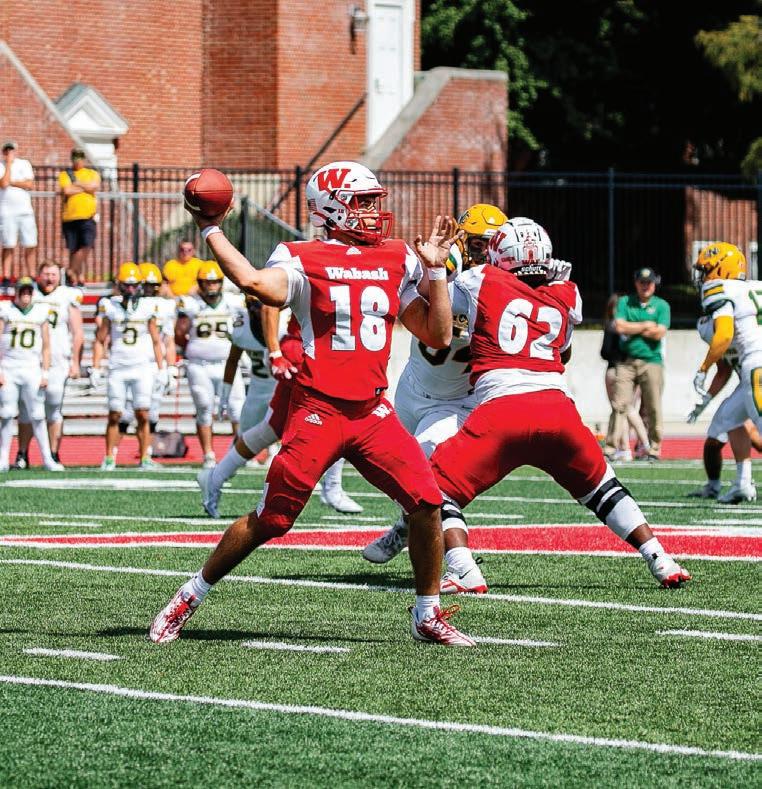
mentor, to help get his replacement up to speed.
“Blake has been awesome,” said Campbell.
“He’s basically a coach now for me, and I think the rest of the team saw that a lot, and kind of rallied behind him as well as me. So we’re all playing team ball – no selfsh ball out there.”
With the beneft of a bye week to get their feet under them. Head Football Coach
Don Morel expects Campbell to join the offense seamlessly without a noticeable dropoff under center. The team also has a stretch of easier weeks before they hit the heart of the conference in late October.
“Every snap [Campbell]
takes, he gets a little better at catching a snap and handling all the calls and emotions,” said Morel. “We’ve got a stretch where Wooster is a decent football team. I think we should beat them, but Brand is going to get about a month of work and then we need to really be ready down the stretch.”
“I don’t think there’s much of a mentality shift,” said Campbell. “I had the same mentality the whole time – ready to play if anything happened to Blake. I was always ready to go in, and, unfortunately, he got hurt. But the mentality hasn’t changed. It’s been all go since I’ve got-
ten here, and that’s what I came here to do, is play quarterback.”
To replace White as punter, the Little Giants have a few options. Cole Dickerson ’28 started against Platteville, putting up 299 yards on nine attempts. Brody Rucker ’26 who handles the team’s feld goals and kickoffs is another candidate. Ultimately the team has a road ahead to move on without White, but a friendly schedule and strong reserves will give Morel and his team a good opportunity to recover from the loss.
COOK ’28
STAFF WRITER
The North Coast Athletic Conference (NCAC) has seen a mix of some impressive and some uninspiring football so far this season.
Teams like Wabash, DePauw and Ohio Wesleyan have shown the ability to score effciently and stife opposing offenses, while teams like Oberlin and Hiram have struggled to compete with even their opponents reserves.
DePauw University – who ascended to rank #18 nationally in the most recent D3football.com standings – has without question been the best team in the NCAC to this point in the season, leading the conference in total touchdowns at 29 and total points scored at 213. They rank frst in offensive yards per game with 459 and have allowed the fewest yards per game at just 219. The Tigers’ defense has allowed just four touchdowns in as many games and has only given up 28 points total. They have outscored their opponents by an average score of 53-7, which is easily the best ratio in the NCAC. Quarterback Nathan McCahill has spearheaded DePauw’s high-powered offense with 967 passing yards while completing 73% of his passes and having an outstanding 16-1 touchdown-interception ratio. The Little Giants have been very impressive as well. They are ranked fourth in the NCAC in points per game with 27, while surrendering 18 points per game. The Scarlet and White has been especially effective on the ground offensively, as they rank second in the conference in rushing yards per game at 146. Wabash‘s pass defense has been quite good as well, as they rank
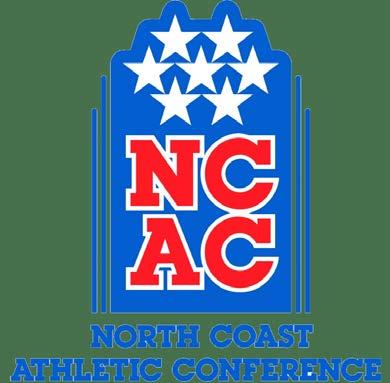
top fve in every defensive passing category. The Little Giants’ defense is led by linebacker Gavin Ruppert ’26 who stands at third in tackles per game with 10.7, second in tackles for a loss with six and is tied for third in sacks with two. Ruppert has also tacked on three passes defended and two interceptions.
Ohio Wesleyan University has been performing at a high level this season too.
Ohio Wesleyan is ranked second in points per game at 32 and in points allowed per game at 16. OWU defense has also been impressive, holding opponents to just 264 yards per game, good for second in the NCAC. They have also picked off opposing quarterbacks 11 times, nearly double that of second-place DePauw with six. Running back Nathan Severs ’28 has easily been the brightest star on the Battling Bishop offense. As a freshman, Severs is averaging 5.3 yards per rush along with three touchdowns on the ground. He has also tacked on 15 receptions and 102 yards through the air.
Oberlin College has had it rough through their frst four games of the season. They are averaging just three points per game while allowing 54 points
per game to their opponents, landing them dead last in the NCAC in both categories. Oberlin has had a lot of trouble moving the ball offensively as they rank eighth in the conference in yards per game at 187. They have also allowed the most sacks out of all NCAC teams with an astonishing 15. Their defense is not doing them any favors either as they are allowing 396 yards per game to opposing offenses, good for eighth in the NCAC as well.
Similar to Oberlin, Hiram College has found it diffcult to produce any positivity on the feld. Hiram has struggled to fnd any sort of offensive rhythm, ranking last in offensive yards per game with 177, last in passing yards per game with 113 and second-to-last in rushing yards per game with a measly 64. While not as bad as Oberlin, Hiram’s defense has been nothing spectacular. One somewhat brightspot has been their pass defense which is ranked sixth in the NCAC in passing yards allowed per game at 200. Their defense has also managed to scoop up two fumble recoveries.
Wooster has stood out both positively and nega-
ELIJAH GREENE ’25
PHOTO EDITOR
It’s the end of the line for Blake White ’25 as the quarterback for Wabash College. After a collision in the backfeld with three defenders in an awkward position, White left Frank Navarro feld with a shoulder injury in the third quarter during the team’s Homecoming game against Ohio Wesleyan. Little did he know, that would be the fnal time he put on his uniform for the Little Giants. White has shown incredible mental fortitude throughout the process of injury diagnosis, surgery and transitioning out of the starting quarterback role that was his for only two short games of his collegiate career. Despite fnding out his season was over before the team’s game against the University of Wisconsin-Platteville, White decided to withhold the information until after the game so as to not distract his teammates from their primary goal of the weekend: winning.
“I didn’t want them to think about anything at the moment [about me],” said White. “Platteville is a pretty good team, and I didn’t think it was the right thing to do to put that on their mind before facing that type of opponent.”
As another demonstration of his commitment to Wabash football, White was already back with the team the day after his injury, leading in the best way he knows how: by example.
“We lifted weights Sunday, and he was at the lift,” said Head Football Coach Don Morel. “That’s vintage Blake. He really has taken on the job of trying to help the young quarterbacks and get them ready. Quarterback is the hardest position in any sport to play, and he has taken 10,000 reps. So he’s really helpful.”
tively. A tale of two sides of the ball has been the story for the Fighting Scots this season, as their inspiring offense currently ranks third in the conference in offensive points per game at 30 and is second in yards per game with 375, however their disappointing defense has been getting exposed, allowing the third-most points to opposing offenses with 31 and allowing the most yards per game in the conference with a shocking 486. The Wooster secondary has been especially bad as they have allowed a conference leading 342 passing yards per game.
Wittenberg, Denison and Kenyon have been stuck in mediocrity thus far. None of these teams have stood out as great or terrible this year, but have found themselves right in the middle of nearly every statistical ranking in the NCAC. However, there have been some bright fashes for these teams, like Wittenberg ranking second in the conference in passing yards per game with 253. For Denison, their defense has made it diffcult for opposing offenses to score, allowing just 17.3 points per game, good for third in the conference. Kenyon has had some success defensively as well, as they lead the NCAC in team sacks with 11.
While Wabash, OWU and others have been impressive thus far, no team has been able to produce the kind of numbers across the board that the DePauw Tigers have been able to this year.
ence running the Little Giants offense will be critical in getting Campbell up to speed to start at the Division III level.
“What Blake is really good at is grabbing the quarterbacks and saying, ‘We ran Trey Right 61 AllGo, you should have thrown the drop out.’” said Morel. “On Saturday [against Platteville], I could hear him screaming all the time, ‘Read, the Mike!’ It’s that instant feedback, and he does it in real time. He’s screaming out onto the feld, trying to help those guys. He’s a consummate Wabash man.”
“Whenever [Brand] is taking reps, I usually stand behind him looking at his feet, making sure he’s making the right reads,” said White. “And if he’s making mistakes, I coach him through them, applauding him when he does well. Everything’s happening really fast, so I want to make sure he’s calm and we’re both on the same page when he steps onto the feld.”
In spite of all these setbacks, White remains confdent and optimistic in his own recovery and the team’s overall potential for this football season.
“The program is bigger than just one player, and we haven’t changed the offense at all. ”
-Blake White ’25
“The program is bigger than just one player, and we haven’t changed the offense at all,” said White. “ I think regardless of whether or not I’m playing, our goals are to win the conference, bring the Bell back home and make a run in the tournament. We still have plenty of great athletes and experience out there.”
“[Blake
White] really has taken on the job of trying to help the young quarterbacks and get them ready. ”
-Head Football Coach Don Morel
A three-year backup behind legendary Wabash quarterback Liam Thompson ’24, the 2024 football season was supposed to be White’s time to shine. With those chances now gone, White has transitioned instantly into a quarterback coaching role, educating and preparing the next quarterback up –Brand Campbell ’27. White has already committed to preparing Campbell to step into the pocket as the new Wabash starting quarterback for the remainder of the Little Giants’ fall campaign. Giving tips on timing, footwork and reads, White’s extensive experi -
While the timing for White could not be worse, the Little Giants football team has weathered the change well. Campbell led Wabash in the second half against Ohio Wesleyan to a 30-13 win, and played well despite losing to UW-Platteville 42-21. What the rest of the season will look like is a tossup. With White’s tutelage and plenty of frst-string snaps, both in game and in practice, Campbell and the Little Giants offense will look to maintain Wabash’s dominance in the conference, placing the team in a strong position at the end of the season to vie for a conference championship and beat DePauw in the 130th Monon Bell Classic in Blackstock Stadium.
“I’m good with the situation we’re in right now,” said Morel. “Because it’s just going to get us better and better, and we will be seasoned for that fnal stretch.”


JORDAN DONSKY ’25
STAFF WRITER
A clash of titans unfolded on Saturday, September 28th, as the Wabash soccer team took on the undefeated Illinois Wesleyan Titans. Under relentless pressure and pouring rain, the Little Giants proved that they are not just contenders, they’re a force to be reckoned with.
In their fnal nonconference game of the season, Wabash squared off against Illinois Wesleyan (6-0-1), a team that had been garnering national attention. After the contest, the Titans received several votes in the UnitedSoccerCoaches.org Top-25 rankings, solidifying their place as one of the premier teams in the country. But it was the Little Giants who took charge early on.
Wabash grabbed the lead in the 12th minute when midfelder Alfredo Campos ’27 made a late run into the box and, left unmarked, calmly slotted the ball past the keeper. Despite dominating for most of the game, the

Little Giants saw their lead slip away in the 77th minute, when the Titans capitalized on a defensive lapse.
“We need to keep a clean sheet and score more goals,” said captain Emilio Paez ’25. “We could have scored mul-
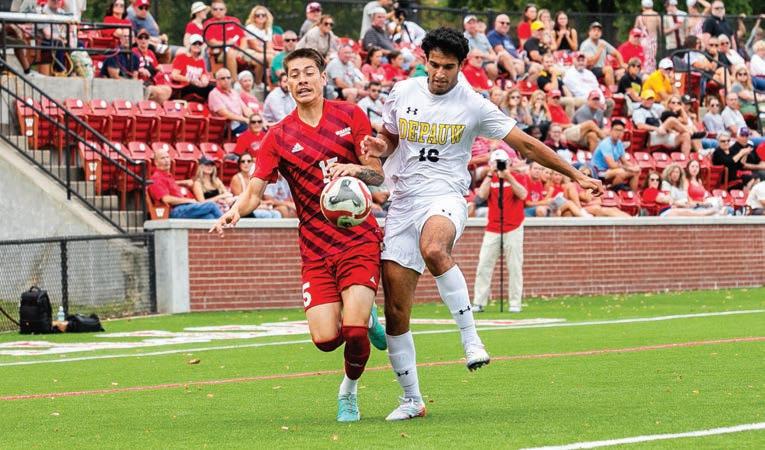
HAIDEN DIEMERMCKINNEY ’26
STAFF WRITER
Wabash soccer is gearing up for a showdown against conference rival DePauw University next Wednesday, October 9. With NCAC tournament implications, this matchup is key for both teams as they fght for positioning in the conference standings. With a week and a half to prepare, the Little Giants seek to open conference play with a crucial victory on the road against their longtime rivals.
The rivalry between Wabash (7-2-1) and DePauw (62-2) soccer has been a challenging one, with Wabash holding a 17-39-5 overall record and an 8-20-2 mark on the road. However, momentum has shifted in favor of the Little Giants in recent history, as they’ve gone 5-32 in the last 10 meetings. In their last matchup on October 4, 2023, Wabash saw a 2-0 lead slip away, fnishing in a 3-3 tie at home.
“It was a tie that felt like a loss,” said goalkeeper Fernando Ramos ’25. “We essentially thought we had it in the bag, but I think that draw really set the tone for the rest of conference play last year.”
Wabash has all eyes set on
DePauw this time around, as the team had no games since September 28. In contrast, DePauw will have played two matches on October 1 and October 5, potentially leaving them more fatigued and giving Wabash a fresher squad with the extra rest.
“I think this week will give us an advantage to mentally prepare for DePauw,” said Ramos. “It’ll allow us to refect on our wrongs, deeply scout in practice and have the rest we need.”
Heading into the matchup, both teams showcase strong offensive threats, with Wabash’s midfelder Alfredo Campos ’27 leading the team with six goals and DePauw sophomore Braden Murphey close behind with fve. One compelling stat is that both Wabash and DePauw are averaging 2.20 points per game on the dot. However, Wabash holds a defensive advantage as goalkeeper Ramos has recorded 26 saves, while DePauw’s goalkeepers have combined for 18 saves this season.
Another interesting aspect of DePauw’s team is that out of the 11 players who’ve played the most minutes this season, nine of them are freshmen and sophomores. With a younger group, the Ti-
gers present a different style of play that the Little Giants don’t often see.
“They play very direct soccer, looking to hit diagonal balls and serve about 50 balls in the box a game,” said Head Soccer Coach Chris Keller.
“It’s not the nicest looking soccer, but it’s effective.”
While Coach Keller understands the youthful energy DePauw presents, he believes in his players to offset and challenge DePauw’s unique scheme.
“We have really good technical ability and some guys that can create and keep the ball,” said Keller. “The more we keep the ball, the less likely they’re able to hit those big crossovers and try to win the second ball, which is what they’re really focused on.”
Although this is a big rivalry that will set the tone for the rest of conference play, the team knows they must approach this matchup like any other game to be successful.
“We know that whatever the result may be, it can directly infuence how the postseason will look like,” said Ramos. “We’ve been having this mentality of taking it one game at a time and getting the job done.”

tiple goals… we just have to execute better.”
“Against good teams, we aren’t going to get the 10 or 15 shots we usually get,” Campos said. “Finishing the three or four chances we have is going to be crucial.”
The result may have felt like a missed opportunity for Wabash, but there were plenty of positives to build on,” said Head Soccer Coach Chris Keller. “We played some of the best soccer we’ve seen this season. I think we found a very good starting 11 that really complemented each other.”
Wabash’s ability to hold their own against one of the nation’s best demonstrates that they’re more than ready to compete with top-tier opponents. Now sitting at 7-21, the Little Giants will enter North Coast Athletic Conference (NCAC) play with momentum. With highly ranked programs like #4 Kenyon and #17 Denison looming on the schedule, Wabash will need to maintain their current form to push for a successful
campaign. Campos has been a standout performer this season, leading the team with six goals. His knack for fnding space and scoring when it matters most has made him the go-to player in the attacking third.
“Against good teams, we aren’t going to get the 10 or 15 shots we usually get. Finishing the three or four chances we have is going to be crucial.”
“This year I’m playing a little higher up,” Campos said.
“I’m just trying to be in the right place at the right time, and my teammates are fnding me in those positions.”
“What people don’t see is Freddy [Campos] out on the feld fve or six days a week all winter and all spring, putting in the work,” said Keller “His teammates have also allowed him to thrive in that role with a great work rate behind him.”
-Alfredo Campos
’27
With key players like Campos stepping up and the team fnding its rhythm, the Little Giants have set the stage for an exciting conference season. The team’s cohesion and adaptability have shown through in every match, and their superb play against Illinois Wesleyan highlights a promising trend. As they head into conference play, it’s clear that Wabash has the potential to turn these strong performances into a memorable season. Each game will be a test, but the Little Giants have repeatedly demonstrated that they can rise to the occasion and compete at the highest level.
Continued from page 1
“Coach Kelly is bringing experience and rugby IQ that the men of Wabash Rugby have never seen before,” said Adam Frey ’27. “This means new drills, plays and strategies.”
In terms of practice specifcally, the role of a head coach should increase effciency and overall skills. Wallace will still lead some practices as well as conditioning and weightlifting, but some responsibility has been lifted off his shoulders with Coach Romano helping.
“Coach Kelly is bringing experience and rugby IQ that the men of Wabash Rugby have never seen before. ”
-Adam Frey ’27
The new implications brought by Coach Romano have quickly made an impact on the players in just two short weeks. Her new mindset and passion have created a spark amongst the team where all players want to improve.
“[Coach Kelly] has a drill for any skill,” said Frey. “Every practice she has introduced at least one new drill so far to work on certain aspects of the game. Everyone is coming eager to play.”
Any introduction of a coach, particularly a frst coach, comes with extreme excitement and readiness to learn and improve. The
communal belief that the team will improve and, in the end, make it to and win nationals is held by all on this team. Coach Kelly Romano has rekindled this fame in many ways.
“The productivity of the team is sky-high. The team has set a goal to not only get back to Nationals this year but to go out there and win it all,” said Wallace.
“The team has responded well to Coach Kelly, and there is a feeling after ev-
ery practice that we are one step closer to reaching our goal.”
The Little Giant rugby team aims high with their frst season accompanied by Coach Romano, but this goal seems extremely attainable. The strong belief within the team that they will improve every day with Coach Romano will get them closer to their goal. The team’s next tournament will be on October 5 at Taylor University.



The Little Giants showed signs of brilliance, but struggled to put together a consistent performance at the Dan Quayle Invitational. Hosted by Depauw University on September 29 and 30, the golf team traveled to Columbus, Indiana where they played a 72-hole tournament at Otter Creek Golf Course. The tournament consisted of one 18-hole stroke-play match and two 18-hole match-play matches.
To kick off the tournament, the team played an 18-hole stroke-play match, meaning each player’s total score was submitted and ranked. Leading the pack for the Little Giants was Sean Bledsoe ’26 who carded a 71 (-1) to fnish tied for fourth overall individually in the stroke-play portion of the tournament.
Matt Lesniak ’25 recorded an 18-hole score of 74 (+2) to fnish tied for 12th and three golfers, Lewis Dellinger ’25, Robert Pruzin ’25 and Lane Notter ’28, all shot 76 (+4) to round out the scoring for the team – each fnishing tied for 24th out of 48 players.
“Otter Creek is not an easy golf course by any stretch of the imagination, and it really forces you to be patient when it comes to birdies,” said Bledsoe. “The front-nine is where you’ve got to grind for pars and try to limit the bogeys, and the back-nine is where you can make some birdies to get a couple of shots back. I did those exact things. I made eight pars on the front-nine, and then took
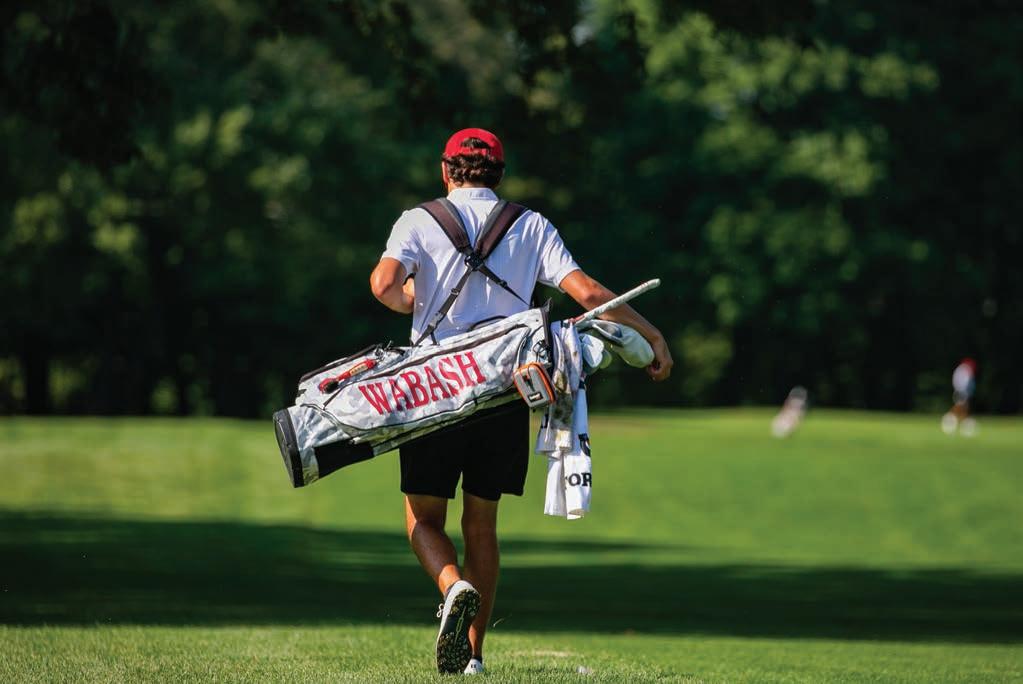
the
advantage of the back-nine by making some birdies.”
The team had an up and down showing in their two 18-hole match-play matches. Match-play is different from stroke-play because a point is awarded for winning that hole. Even if you win by three strokes, you only receive one point. The player with the most points at the end of the match wins a point for their team.
Lesniak’s frst 18-hole match of match-play included diffculties not only

SAM SANTIAGO ’26 STAFF WRITER
The Little Giants took a road trip to the Chicago region to face the Tigers of Olivet Nazarene University in their fnal match of the fall season. The contest was held on Saturday, September 28 in Bourbonnais, Illinois.
There was no offcial score taken throughout the match but it was a fantastic opportunity for guys to play great competition and gain experience. There were a total of fve doubles matches and 10 singles matches.
“We look at these matches as a chance to grow, in these matches it’s not about the results as much as it’s about taking the opportunity to get better and push ourselves to be the best players we can be,” said Ethan Koeneman ’26. “These matches against good teams in the fall are only going to help us improve and beat teams in the spring season.”
In the doubles matches, the Tigers took the frst four matches, but Maksymilian Domanski ’28 and Fuastino Dimuro ’28 were able to secure a strong win at 5-doubles. The singles matches
were very competitive as well. Vittorio Bona ’27 and Ethan Koeneman ’26 both dropped tight three-set matches at 2-singles and 6-singles.
“The match went well,” said Bona. “In the frst set I waited for my opponent to make errors and made sure to capitalize on them. I was up in both the frst and second set but, ultimately, I lost my focus for the rest of the match. It’s good to have these matches because I am able to work on many things whether that be mentally or in the matches.”
Chris Zimmerman ’25 picked up a singles win at 4-singles with a tough three set match. Wabash really shined bright from the 8-singles through 10-singles, with Jett Brownlee ’25, Eduardo Werneck ’26 and Dimuro all winning in straight sets. Overall the Little Giants won fve of the total 15 matches, but there was a lot of close tennis that was decided by a handful of points. This match spells the fnal competition of the fall schedule but the team will continue practicing through parts of October.
against his opponent, but against time. After fnishing the 13th hole of the match up two points on his opponent, the match was suspended due to lack of daylight and set to resume in the morning. In the morning, both golfers returned to fnish their match before the second schedule of matches could begin. Lesniak lost the frst hole after resuming play and was one up with four to play. He responded by tying holes 15 and 16 then winning hole 17 to end the match. The match
concluded because it was mathematically impossible for his opponent to win after that.
Unfortunately, Lesniak’s victory was in the minority as the team fnished tied for fourth out of eight teams for match-play results. Denison left the 36-hole match-play portion victorious.
“I was really happy with how I came out and fnished the frst match after being stopped due to the lack of light,” said Lesniak. “It’s not easy to go back out there and
fnish after you’ve been in a groove and riding the momentum of being ahead. My second match wasn’t great. I and the team are focusing on being able to keep our bad rounds at lower scores and get our good rounds to be more competitive.”
“I think that this tournament showed us what we need to do to be able to compete for a conference championship,” said Bledsoe. “It is no doubt that we have one of the toughest conferences in the country because there are
four other schools — Kenyon, Wittenberg, Denison and Depuaw — that have a really good shot at winning the North Coast Athletic Conference (NCAC) championship and competing for a national championship. So now we know the level of play that it will take for us to beat those schools, and now it’s our job to become better players through grinding and practicing to beat those teams.”
The Little Giants will be hosting their next match, the Wabash College Invitational, on October 7 and 8 at Broadmoor Country Club. The team hopes to build on the positive moments from this match and continue to focus on playing smart, strategic golf that emphasizes pars and limits bogeys.
“This week we need to really grind tee shots and wedge work,” said Dellinger. “At the Crawfordsville Country Club [where the team usually practices], sometimes we can get lazy spraying the ball off the tee, but, at a course like Broadmoor, if we don’t fnd the fairway we could be in for a rough 54 holes. I’m confdent in the practice plan [Head Coach Justin Kopp ’21] has put together to get us dialed up for this next week. As I previously said, our wedge work needs to be impeccable at a Donald Ross course. If you hit a shot from within 100 yards to the wrong side of the green or long of the fag, you could be really penalized and even be fghting for a double bogey.”
MALACHI MCROBERTS ’27 STAFF WRITER
When the Little Giants need a big stop, Gavin Ruppert ’26 is there to deliver. Same faces, new defense has been the theme so far for the Wabash defense this season. The mostly retained defensive personnel have taken massive strides so far this season, and most notably has been Ruppert at inside linebacker.
In 2022, the freshman linebacker out of Greenwood, Indiana made an immediate much needed impact for the 7-3 Little Giant’s roster, which particularly struggled on the defensive side of the ball. In his frst season of play, Ruppert led the team with 95 tackles and six and a half of those tackles were for a loss in just nine games. Following up on his freshman year he once again led the team in tackles with 73 during his sophomore campaign, which helped Wabash’s run defense drastically improve from 2022.
pretty happy. When I found out he was just going to be a junior, I was really happy. So, I think he’s got a lot more in the tank.”
This scheme is not the only thing that is amping up the production for this defense, Gilbert’s overall philosophy has made a no-
top of that, the defense has forced three fumbles and recovered two of them.
“We want to celebrate takeaways,” said Gilbert. “We want to make sure our kids understand that it’s a huge game changer, it’s also a ton of fun. We try to be respectful of the offense, but at the same time, if we get an interception, I want our kids to react like we just won the game, because, in reality, we probably did.”

Ruppert has continued being a force for this Wabash defense, which is greatly exceeding expectations. Ruppert has been all over the feld so far, having already racked up 32 tackles, six for losses, and two sacks in just three games. With two more sacks and almost triple the amount of tackles for a loss than last season, Ruppert has been pivotal for the defense’s front seven, flling in gaps and even disrupting and pressuring the quarterback on specially designed blitzes. “I thought [Ruppert] was a great player last year when I watched the flm to take the job,” said Associate Head Coach and Defensive Coordinator Jake Gilbert ’98. “He was the frst guy I really noticed and asked about. When I found out he was coming back, I was
Ruppert, under Gilbert’s scheme, has been able to display his prowess in several areas especially within pass coverage in the middle of the feld, where he has already snagged two of the team’s fve interceptions.
ticeable impact. Gilbert has focused on playing aggressive and forcing takeaways.
“When I found out [Ruppert] was coming back, I was pretty happy. When I found out he was just going to be a junior, I was really happy.”
“Coach Gilbert brought in a new scheme where I feel like I can play more freely and be looser,” Ruppert said. “The kind of belief he’s instilled in me, that I can be the best player on the feld at a given time, and that’s a belief he instills in all of us, no matter who we are playing, no matter the opponent. We can be the best defense in the conference.”
“We think takeaways are the most important stat, so we measure that as our top goal,” said Gilbert “If we don’t get a takeaway in a practice period, we just run immediately, because I really want the players to feel like that’s what matters most.”
This focus has already been demonstrated on the gridiron. The Little Giants have already forced fve interceptions in just three games, which is only two fewer than the seven picks they had last season. On
Their philosophy, confdence, as well as an extra year of continuity, have assisted in the overall progression of the defensive secondary, which was a huge question mark coming into the season. Avery Epstein ’25 and Mike Holsclaw ’26 have been tearing it up at corner this season combining for the other three interceptions this year. Safety Brock Robertson ’26 has been a standout in run support this season, and the team has fnally gotten to see what a healthy Jake Pasch ’26 can do as a well-rounded safety, causing problems in the run support and pass coverage. This secondary backing up Ruppert and the rest of the linebacker room is a recipe for success.
An improved secondary paired with a front seven that is not afraid to bring pressure and blitz, has been a game changer for this defense that is looking to shoulder a heavy load moving into conference play. If the secondary maintains this positive momentum going forward, Ruppert will continue his reign of terror in the middle of this Wabash defense for the remainder of the year.
“I think he’s an extraordinary player,” said Gilbert.
“So we do try to showcase him and get him where the ball is going to be, so if we can have him at the point of attack, typically, good things happen for us.”